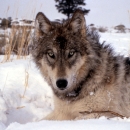Featured Species
Yreka FWO biologists monitor the status and support the recovery of several species of rare fish, wildlife, and plants, from furry mammals like the fisher, to the old-growth forest dwelling Northern spotted owl, to the small and secretive Shasta salamander group, the elusive Franklin's bumble bee, and colorful plants like the Yreka phlox. We work with landowners and leading scientists to gather the best available science on each species and their habitat, and work with our many partners to implement on-the-ground conservation that supports their recovery.
ESA status means the level of protection afforded the species under the Endangered Species Act, if such protection has been warranted. Other species may be under review for proposed protection, or not warranted for protection. There are two levels of protection under the ESA: "threatened" which means a species is likely to become endangered in the foreseeable future throughout all or a significant portion of its range, and "endangered" which means a species is in danger of extinction throughout all or a significant portion of its range.
At-risk species our office works with include:
Amphibian
- Cascades frog
- Foothill yellow-legged frog
- Siskiyou Mountains salamander
- Scott Bar salamander
- Western pond turtle
- Western spadefoot
- Shasta salamander
Insect
Mammal
Plant
Mollusk
Aquatics
Check out some of the species our office is responsible for monitoring and recovering below:








